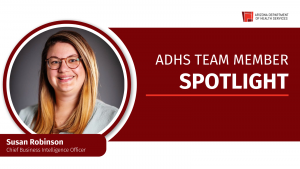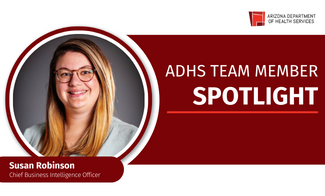 Public health data helps ADHS tell the public where disease is occurring and who is most affected. An example is high COVID-19 death rates among seniors compared to other age ranges in Arizona. This helps people make informed personal decisions on how best to conduct their activities.
Public health data helps ADHS tell the public where disease is occurring and who is most affected. An example is high COVID-19 death rates among seniors compared to other age ranges in Arizona. This helps people make informed personal decisions on how best to conduct their activities.
That’s why I’m pleased to highlight Susan Robinson, ADHS’ Chief Business Intelligence Officer. She’s among the team members featured on our ADHS Careers website.
Susan joined us straight out of graduate school as an epidemiologist working to prevent measles, mumps, and whooping cough. And her career trajectory demonstrates the opportunities ADHS offers. In 2018, as the opioid epidemic brought challenges that called for new public health approaches, Susan joined a cross-disciplinary team that reimagined data reporting.
“I love data. I love talking about data points and graphs and all of that stuff,” she says in a video featured on our ADHS Careers website. “What a wonderful way to have the ability to totally nerd out matter to an entire community.”
In 2020, that approach to data informed how Susan and the informatics team she led presented COVID-19 information so public health professionals and the public could better understand this unseen enemy. You’ll find it on our COVID-19 Data Dashboard and elsewhere on the ADHS website.
But the value of collecting, analyzing, and visualizing data extends across the spectrum of public health. We use data to monitor different parts of our health system such as our EMS 911 call volume, note possible impacts to health from the environment, and track our vital statistics for the state.
Today, Susan leads an expanded team that supports much of the data that comes in and goes out of the department. These areas include our electronic surveillance system, cancer and birth defects registry programs, vital records/vital statistics, hospital data and systems (including emergency medical services systems, hospital discharge and cost reporting, and syndromic surveillance), geographic information systems, and the visual analytics team.
Another timely example of their work involves respiratory syncytial virus, or RSV. Health care providers closely follow the RSV dashboard to see when RSV season has begun and how it’s progressing so they can administer a drug, palivizumab, to high-risk children under age 2.
While innovation and out-of-the-box thinking have always been hallmarks of public health in Arizona, Susan and her team exemplify how ADHS is meeting today’s unprecedented challenges and opportunities.
“There is so much need for new energy right now,” Susan says. “Everyone’s got a seat at the table because we’re about to make a phenomenally huge shift in the basic 101 of public health.”
If a career in public health appeals to you, I hope you’ll learn more about Susan in the video below and about team members featured on the ADHS Careers website. These professionals make a difference for Arizonans every day.










